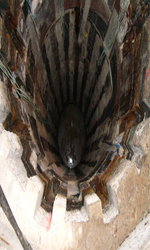Work package 4: Disturbed host rock (DHR) formations
For more information, please contact Jon Harrington, (WP4) leader.
Construction of any underground opening results in a re-distribution of the local stress field. At depth it is possible to remove mass from the system (e.g. tunnelling), but it is not possible to remove the stress. Therefore the rock surrounding the opening has to accommodate the load that was originally borne by the removed rock, leading to a localised stress concentration. In most geological setting, rocks at depth are at a point of limiting equilibrium, i.e. they are at a stress state just short of failure. Therefore, any stress re-distribution is likely to result in failure of the host rock. Failure is usually observed in the form of a complex fracture network, which is heterogeneous in distribution around a circular tunnel opening because of the heterogeneous stress distribution. The orientation of stress with respect to the fracture network is known to be important. The complex heterogeneous stress trajectory and heterogeneous fracture network results in a broad range of stresses and stress directions acting on the open fracture network. During the open stage of the repository, stress will slowly alter as shear movements occur along the fractures, as well as other time-dependent phenomena. As the repository is back filled, the stress field is further altered as the backfill settles and changes volume due to resaturation. Therefore, a complex and wide ranging stress regime and stress history will result. As such, there is a need to understand the roles of the stress tensor, the stress path and associated mechanical deformation in determining permeability changes affecting the sealing efficiency of the host rock. The work package is split into three main areas, laboratory, field and numerical simulation. The objectives of this integrated work package are:
- Perform laboratory scale experiments to: (a) provide data to test, develop and validate theoretical frameworks and predictive tools to analyse the effects of the stress tensor, the stress path and associated mechanical deformation in determining permeability changes affecting the water and gas sealing efficiency of the host-rock following repository closure, (b) examine the role of the stress tensor orientation with fracture orientation and examine the conditions under which fractures become conductive, (c) examine possible radionuclide movement in an artificially damaged plastic clay formation (Boom Clay) supported by X-ray tomographic techniques (a technique successfully applied in the SELFRAC Project), (d) examine the permeability evolution of the seal plug/host rock interface supported by X-ray tomographic imaging of test cores.
- Perform field-scale experiments to: (a) provide a comprehensive insight into the hydro-mechanical behaviour of a fractured EDZ in an indurated mudrock formation (Opalinus Clay) in transporting gas along the backfilled tunnels and seals; (b) examine EDZ-sealing, radionuclide (Radionuclide) migration and gas movement in a plastic clay formation (Boom Clay) simulating the expected sequence of phenomena in a medium-level waste (MLW) repository that could lead to gas-driven radionuclide transport; (c) investigate the hydro-mechanical behaviour of the EDZ in a disturbed crystalline rock formation (granite) and its role in the movement of repository gases; (d) examine issues of up-scaling from laboratory to field-scale experiments.
- Undertake detailed numerical modelling of laboratory and field scale experiments with particular emphasis placed on the assessment and application of constitutive models to describe hydraulic and gas flow properties in a clay-based EDZ. This will be facilitated through the development of strong interactive links between modelling and experimental teams.

